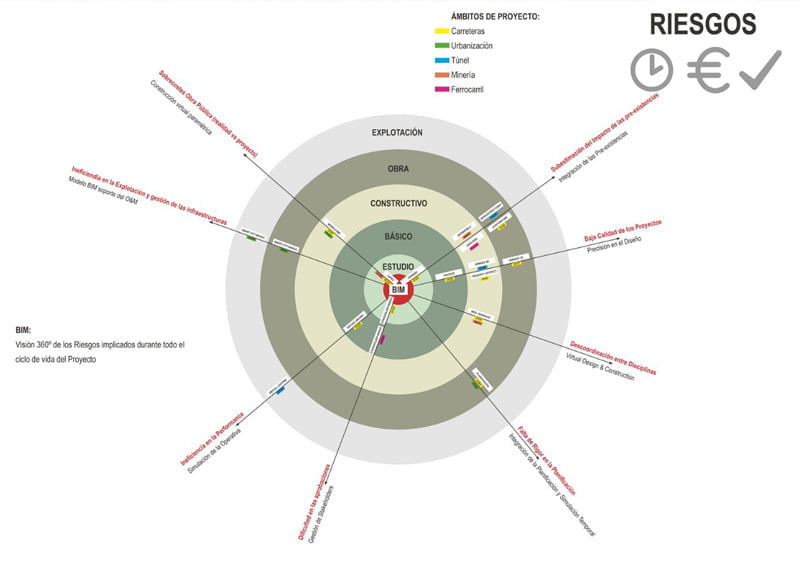BIM as a Risk Management tool


IDP has participated in the program “BIM 360º an integral vision” organized by the Catalan Civil Engineers’ Association, where civil engineering experts gathered to analyse, from different points of view, what key factors are transforming the sector.
Those attending the conference have learnt about the latest developments in the industry, the challenges and opportunities foreseen in the sector and have exchanged points of view through case studies, project presentations and a roundtable.
IDP, represented by the architect Adriana Caballero, participated in this edition presenting “Risks and Added-Value Contributions in the Infrastructures’ Life Cycle”.
RISKS AND VALUE CONTRIBUTIONS IN THE INFRASTRUCTURES’ LIFE CYCLE
The life cycle of infrastructure projects includes five main phases: Study, Basic, Constructive, Construction and Exploitation.
Each of these phases face the management of three large risk packages: time, cost and feasibility. These risks appear in the form of concerns in our clients, and in order to analyse them thoroughly, they have been listed with the consequent added-value contributions of the IDP group in the last projects carried out in the area of Infrastructures:
- Underestimation of the Impact of the pre-existences: By raising Point Clouds for visible pre-existences and the geotechnical survey of the terrain for the non-visible ones, as well as their integration in the BIM Model, we minimise the risks posed by these pre-existences.


- Low quality of the projects: With the precision contribution in the design of the project, we avoid postponing the solutions on site and through internal control measures, we guarantee document coherence, thus improving the quality of the projects.
- Lack of coordination between disciplines: This point appears as one of the most relevant concerns of the clients. Our added-value contribution is structured from the rigour in the Modelling, the Process optimisation and the Communication agility.
Rigour in the Modelling: The Modelling is carried out in accordance with the construction of the project (Virtual Design and Construction).
Process Optimization: It is designed simultaneously to the coordination between disciplines. The moment you start designing, you start to coordinating, either internally or working with other companies / external agents.
Communication Agility: Communication of interferences and / or incidents is done through BCF (Bim Collaboration Format) in the cloud. This measure allows optimising the flow of information and eliminating the traditional channels (email, telephone) that do not allow getting performance statistics and consequently improving it.


- Lack of Planning Rigour: The integration of planning in the BIM model allows verifying, by means of a temporary simulation, that the adopted solution is the most optimal one according to timing and particular requirements of the industrial partners and construction agents.
- Difficulty with Stakeholders’ approvals: The parametric relationship between the model and its realistic graphic visualisation facilitates the understanding of the project without sacrificing postproduction hours for that purpose.
- Performance Inefficiency: Simulating the operation of the adopted solution during design phase. For example, through the BIM Driving and a Light Study we obtain information about the user experience regarding the driving in real time.
- Inefficiency in the Exploitation and Management of the Infrastructures: Using the model BIM As Built, once the construction is finished, as support of Operations and Maintenance.
- Overhead costs of public works (reality vs. project): Calculating the CAPEX in the study phase and OPEX for the Exploitation phase, as well as integrating the cost in the Construction Models to manage the bids in the Construction phase.
As a result of this analysis, the IDP group currently classifies all its projects not only in terms of the area to which they belong (Roads, Urban development, Tunnel, Mining, Railway, etc.), but also in terms of the stage(s) in which it participates, and the concerns that it resolves, offering a 360 degree Vision of the Risks involved during the entire project’s life cycle based on an extensive and continuously updated history.
IDP implements the BIM methodology to improve the analysis and management of risks in the different phases of the project life cycle, allowing to minimise the deadlines schedule and the final cost.











